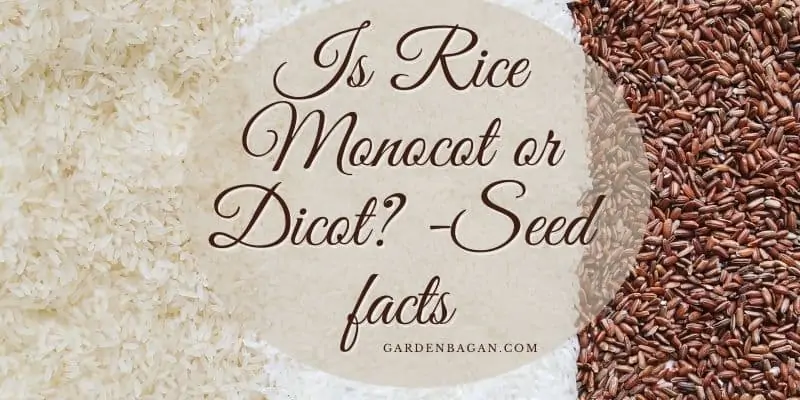Rice is a common grass. It is one of the largest consumed cereal grains. I think every reader of this post knows what rice is? So without wasting any time let’s come to the point. Today we will discuss the nature of the rice seed. The topic of today’s discussion- whether Rice is a Monocot or Dicot seed.
Before proceeding let us understand few basics about seeds. You will occasionally read or hear about cotyledons. So what is it?

You should also read- Is Rice, Wheat Grains are Vegetable? Kitchen Garden facts
What are Cotyledons?
The term cotyledons mean the primitive division of gamete cell. In simple words, we generally refer to the covering or the first leaf sets to denote cotyledons.
Technically the hard covering attached to the primitive leaf is said to cotyledons. Some seeds have two distinct sets of covers with two primitive leaf sets. These seeds are called Dicots Whereas seeds with a single covering are called monocot seeds.
The term monocot means single cotyledons. It signifies a single covering to protect the baby plant inside the seed. Dicots stand for two distinct cotyledons. Two covering on the adjacent side of the primitive leaf set or the baby plant is observed in this case.
Now, let us move to our today’s topic-
Is Rice Monocot or Dicot?
Yes, Rice is a Monocot. It is quite simple to say but don’t trust my words. First, read it, understand it and then try to observe the facts on your own.
Ok, if Rice is a monocot then what are the facts to prove that?….
- The first fact is you cannot divide the rice kernel to see the leaf inside.
- Rice plant does not grow leaf set in pair. In fact, the first leaf grows alone followed by another one. In dicot seeds, Leaves always grows in pair. You can see the first two leaves easily inside the dicotyledons.
- The root and shoot system grows simultaneously in a dicot. But a Rice kernel first develops the root and then grows continuously to develop the first leaf.
- The leaf and roots inside a rice kernel are not distinct until the time of leaf formation. On the other hand, a distinct leaf set and tiny root can be observed inside a dicot.
All these facts are simple technical comparisons. You can easily try these to observe the difference between a dicot seed and a monocot rice kernel.
To verify these facts take a pea or gram seed and some rice kernel. Pea or gram seeds are dicot in nature. So it is very easy to split the covering and observe the leaf set inside. But this is not that easy with rice kernel.
Most of Rice kernel is cylindrical or close to that shape. There is no single point to split the seed. Simply you can’t split a rice seed into two equal vertical parts. The seed contains a solid core covering the germ.
Check out my previous post- How is soil a Heterogeneous Mixture?
The distinction of Rice as a Monocot
We have discussed the nature of both monocot and dicot seeds. Also, we have classified Rice as a monocot. Now if I say rice is a monocot would you trust me? I hope so.
But if you still have any doubt then check for following in any monocot seeds
- Single solid seed body. Ideal monocot seed must have a single solid undivided structure.
- No distinct separation or hemisphere present. These hemispheres are the cotyledons, you can find these in dicots.
- The germination process differs in primary stages. First, the root comes out from one end, and latter the leaves develop from the same point. In dicots, both the root and shoot are already distinct before germination.
- The leaves grow simultaneously in most of the monocot varieties. In dicots you can observe pair of leaf sets grows simultaneously. Though this distinction is not always correct. Some monocots can have leaf set pairs.
- Monocot seeds grow in bunches, most of the time each monocot is the fruit itself. This is not the same as a dicot. Generally, a dicot seed grows in groups of 4-5 or a little more inside single fruit.
- Monocot plants have smaller flowers compared to dicots. They also lack bright vivid coloring. Though this fact is not always true. Sometimes this can differ, the exception is a part of nature.
I hope you like my work. I have tried to keep it as simple as possible. If something is not right or maybe something is missing then please let me know. If you think my work is useful then share this and also let me know your thought.
I’ll be back with another interesting topic of discussion. Till then Keep reading Keep Gardening.

